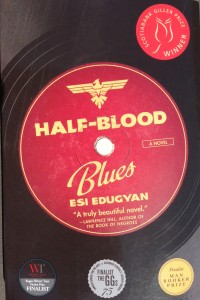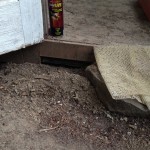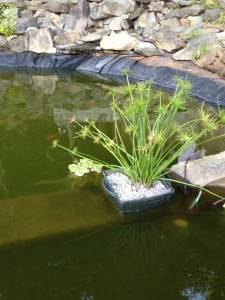AUTHOR ESI EDUGYAN

Earlier this month I had the pleasure of meeting Esi Edugyan, the author of Scotiabank Giller Prize winning Half-Blood Blues at the Denman Island Readers and Writers Festival, and to hear her read excerpts from her latest novel. At that time I had only just begun reading it, and as of last night, I am done. When we spoke, I asked her about the used of dialect in her book, which is populated by a mix of jazz musicians hailing from Baltimore, Chicago, New Orleans, Montreal, Germany and France. The use of the Baltimore”black” vernacular of narrator and protagonist Sidney Griffiths, in particular, as well as his motley crew of compatriots, is important because it contributes greatly to both the development of character, as well as to distinguish between one and another, and also plays a critical role in painting the mood and experience of that time and place: World War II Berlin and Paris. Several of the books reviewers, and several of the commenters at the conference, referred to the rhythm and tone of the language, and how it animated the story and lent it the musicality and feeling of the jazz music of the era. While I don’t disagree with this, and I very much enjoyed the language of the novel, this was not my main focus.
USE OF DIALECT IN FICTION
As a writer, I was principally interested in how she had researched the dialects she used, and how, as a writer she had decided how much, and which elements, of vocabulary and syntax she decided to use and which to leave out. This is what I asked her about. She answered that she had sourced and listened to recordings of spoken word by contemporary jazz musicians, including Louis Armstrong who is a minor character featured in this novel. She also said she had to use a lot of discretion to find the right balance between illuminating character and culture, and keeping the language clear enough to not alienate or confuse readers.
I dealt extensively with this problem in one of my own books (The Aviary) which features a Canadian woman in Yorkshire, who is surrounded by characters who all have an accent of one kind or another (to her ear), and finds herself quite challenged by the famously difficult Yorkshire dialect. I have received a fair bit of feedback from editors and beta readers about this at various stages, and made many changes to try to find the right balance.
Esi agreed, stating that she believes it was the extensive use of dialect that initially made the novel difficult to sell, and she did make changes accordingly in response to her editor’s feedback. Certainly there are many examples of excellent novels that use dialect to varying degrees. I find it hard to believe that so many readers find it so impenetrable as to limit an author’s creative freedom (unless you happen to be Peter Carey, but even he gets flack, apparently). The sound of language is so important to one’s experience of a story, I would think those in the business, and those who love to immerse themselves in a good story, would be more flexible and tolerant, and willing to do that tiny bit of extra work that it takes to become familiar enough to overcome any initial challenges. But apparently not. Or not often enough for publishers to take the risk.
CHARACTER, EGO, AMBITION, FRIENDSHIP AND VALUES
As a reader, I have to say the element of this story I found most compelling was the flawed main character and narrator, Sidney Griffiths, himself. Sidney is a sensitive guy with big dreams, too sensitive we and he think, for some of the company he keeps, including his life long friend and companion Chip Jones, a hard edges, big mouthed and often crude character whose friends seem to tolerate him because he’s sometimes funny and also a great drummer. Too sensitive, we also think, when Sidney’s disappointments, sense of betrayal, and lurking mistrust of others ends up alienating him from them. It is his own frailty as a human being that ends up doing him the most harm, as he lashes out and behaves in less than admirable ways simply because of his own frustrated ambition, or desire. Sidney, however, and I have to think Esi did this quite consciously, seems a bit more ordinary that the other characters in the book. He is neither an eccentric nor a genius, nor terribly damaged, as it turns out, neither a coward nor a hero. It is this very ordinariness that makes him sympathetic, and helps us to step in his shoes as he and his friends are tossed about by the winds of fate.
Without spoiling the story for those who haven’t yet read it, I will only say that it raises several questions for me, such as: When should we acknowledge that our youthful dreams of greatness will never be realized? Perhaps we haven’t been given the talent, the determination or the luck to make it happen. Is it more important to do a thing exceptionally well, or to do a thing because it brings you joy? Is any sacrifice or choice justifiable in the pursuit of excellence? Of success? Even when it hurts others? When our life is over, will we value our accomplishments more, or the people with whom we shared the journey, for better or worse?
EXCELLENCE VERSUS JOY
Near the end of the novel, there is an exchange between Chip and Sid about whether and why they continued playing the jazz music throughout their lives. Sidney says, “It was supposed to be this joyful music. And I just couldn’t find none of that joy in it no more.” And Chip’s reply is interesting. He says, “I don’t understand that at all…The music is the joy. That’s how you find it again. By playing.”
In some ways, it seems to me that Sid deprived himself of the joyful music because of the pain and sense of loss and guilt he suffers, because of other decisions and actions he made in his life.
What do you think? Is it more important to do a thing exceptionally well, or to do a thing because it brings you joy?






